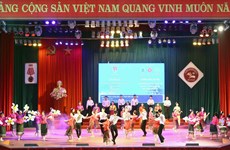8 million ethnics to benefit from improved land management project
About 8 million ethnic minority people in Vietnam will benefit from a project to promote their access to and management capacity of farmland and forest land, CARE International said.
 About 8 million ethnic minority people in Vietnam will benefit from the project (Photo: VNA)
About 8 million ethnic minority people in Vietnam will benefit from the project (Photo: VNA)Hanoi (VNA) – About 8 million ethnic minority people in Vietnam will benefit from a project to promote their access to and management capacity of farmland and forest land, a representative of CARE International said on January 19.
At the project introduction workshop, CARE International’s Acting Country Director in Vietnam Biniam Haile said, with a financial support of over 700,000 USD his organisation will work with the organisation – Culture Identity and Resources Use Management (CIRUM) and the Vietnam Administration of Forestry, to carry out the project in Lao Cai, Lang Son, Nghe An, Ha Tinh, Quang Binh and Kon Tum provinces from the beginning of 2016 through 2018.
About 8 million ethnic minority people will benefit from the project through the consultation and amendment of the Law on Forest Protection and Development and other policies, as well as the expansion of the project’s successful activities.
Ethnic minority communities have the highest poverty rate in Vietnam, and they mainly rely on natural resources, especially forest land, for their livelihoods.
Many studies have shown that one of the main reasons of ethnic minority groups’ poverty is the shortage of farmland. More than two-thirds of ethnic minority people have their livelihoods completely dependent on farmland and forest land, and they live under the poverty line, according to CARE International.
They also face an array of difficulties caused by population pressure, forest degradation, the shrinking of forest land area, and resources exhaustion. Such a fact is partly attributable to the inefficient governance of natural resources, particularly forests and forest land, and many local forest management methods - based on unproven customary law.
CIRUM Director Tran Thi Hoa said the project will provide ethnic minority women, who are in the most disadvantaged group, with financial aid to encourage them engage in the decision making process during land and forest, management and use. They will also have chances to participate in workshops, discussions and policy dialogues.
Hoa hoped the effective community-based forest management models of the project will be taken into consideration by policy makers during the revision of policies on land and forests.-VNA













